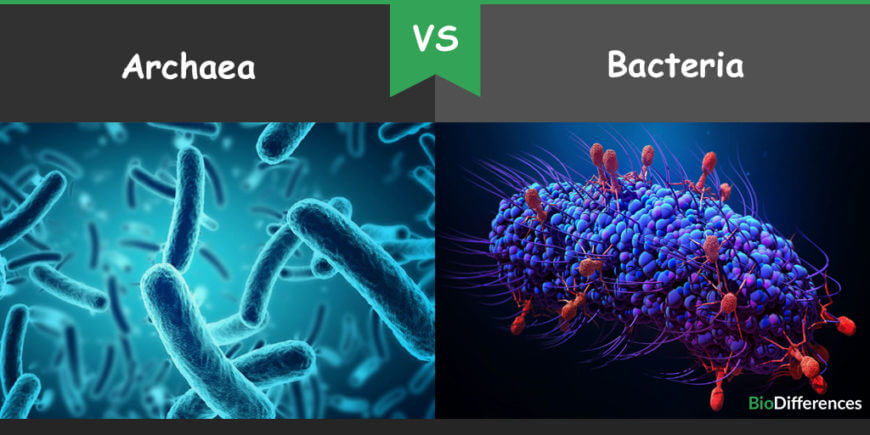Difference Between Archaea and Bacteria – Archaea vs Bacteria


Microscopic small organisms are generally able to survive and thrive universally, and in any condition, no matter how extreme. These cells date back to more than 3 billion years ago.
Of all the cells found on this planet, we will be talking about Archaea and Bacteria. These two belong to the prokaryotes group and are part of the Monera kingdom.
Archaea are often thought to be one of the most ancient or primitive life forms. It is considered to be related to the very first cells which arose billions of years ago on this planet. Archaea was actually first classified as bacteria.
It was only later that they got the name “archaebacteria” and that was because they possessed some special features. Even though just like bacteria, they occupy a very significant position of the kingdom and are found very commonly, but they differ in various ways as well.
Even though Bacteria and Archaea belong to the same group of prokaryotes, but they show marked differences in their genetic structure. The enzymes and metabolic pathways that are possessed by Archaea resemble eukaryotes more than any bacteria.
An Archaea’s cell wall resembles pseudopeptidoglycan. It consists of peptidoglycan with lipopolysaccharide or muramic acid. The cell wall forms the outermost layer and it assists in maintaining the chemical equilibrium as well as the shape of the cell.
Inside it, there are other types of genetic material and cellular debris. Bacteria are prokaryotic organisms who lack nucleus as well as other organelles that are membrane bound.
Their entirely bodily process takes place right in their cytoplasm itself. The cell is surrounded by an enveloping material that supports, protects and even regulates the transport of bodily materials.
Archaea has ether bonds with the branching of aliphatic acids in their lipid membrane. This is different from bacterias since they have lipid membranes of ester bonds with fatty acids.
While Archaea doesn’t follow the Krebs cycle or glycolysis but it does use similar pathways. It basically makes uses of both to break down the glucose. Bacteria use the ribosomes to carry out protein synthesis.
When it comes to reproduction then Archaea reproduces asexually by making use of binary fission, the budding process of fragmentation. Bacteria, on the other hand, produce spores that let them live even in very unfavorable conditions.
Bacteria reproduce sexually as well as asexually too. Archaea have just one flagellum which helps with their motility.
Archaea comes in different kinds of shapes like plates, spheres, and spirals. Some Archaea might be square or flat shaped as well. When it comes to size and shape, Bacteria can be found in many different kinds of forms.
When it comes to shapes, Bacteria can be in the shape of a rod, cocci, spherical or spiral.
Archaea range in size to just a few micrometers. The sizes generally range from 0.5 to 4 µ. When it comes to Bacteria then their size can vary from 0.2-1.5 µ in diameter.
There are some other minor features of Archaea which should be noted. The substance Thymine is not present in the (transferase RNA) and Introns are present in Archaea. Moreover, the RNA polymerase in Archaea is complex and is made up of 10 subunits.
The last thing tonite is that Archaea are not pathogens. This all is in direct contrast to how bacterias function. For example, bacterias are actually pathogens and their simple RNA is made up of 4 subunits.
Archaea and Bacteria have a lot of differences but they have some similarities as well:
Till now only three types of Archaea have been found. They are Thermophiles, Halophiles, and Methanogens. Here’s more about them in browser detail:
The last one stated above, Methanogens are part of the most diverse Archaea group. They are useful in wastewater treatment since Methanogens are able to convert carbon dioxide and waste products into methane.
Methanogens are found mostly in marine sediments and wastelands. Some common examples of this kind of Archaea are Methanobacterium and Methanococcus.
These are the Archaeans that can survive in very high temperatures and thus this name has been given to them. They can survive between 41 to 140°C or 106 to 252°F with ease. Thermophiles are further classified into hyperthermophiles and extreme Thermophiles.
Extreme thermophiles can survive in temperatures between 65 to 79°C whereas Hyperthermophiles can survive temperatures of 80°C and beyond. But the latter cannot stand temperatures below 50°C.
Thermophiles are also used in biotechnology for carrying out PCR or Polymerase Chain Reaction. Some examples of this kind of Archaea is Thermuococcus litoralis and Thermus aquaticus.
Halophiles are salt-loving Archaea. These are found in places with a very high concentration of salt. Places like the Great Salt Lake or the Dead Sea are full of Halophiles. Some examples of this kind of Archaea are Halococcus and Halobacterium.
There are two kinds of Bacteria:
Gram-positive Bacteria are named such because they depict a positive result and are purple in color. Some examples of this type of Bacteria are Streptococcus, Bacillus, and Staphylococcus.
Gram-negative Bacteria doesn’t have any violet stain. Some of the examples of this kind of Bacteria are Shigella, Pseudomonas and Salmonella.
So after considering the difference between Bacteria and Archaea one can find that they are quite different.
Even though both of them show some similarities but they vary in other important ways like in terms of cell structure, reproduction methods, metabolic pathways used, shapes, sizes and even more.
Moreover, these two microorganisms also prosper in various different environments and so they are put in different groups.
